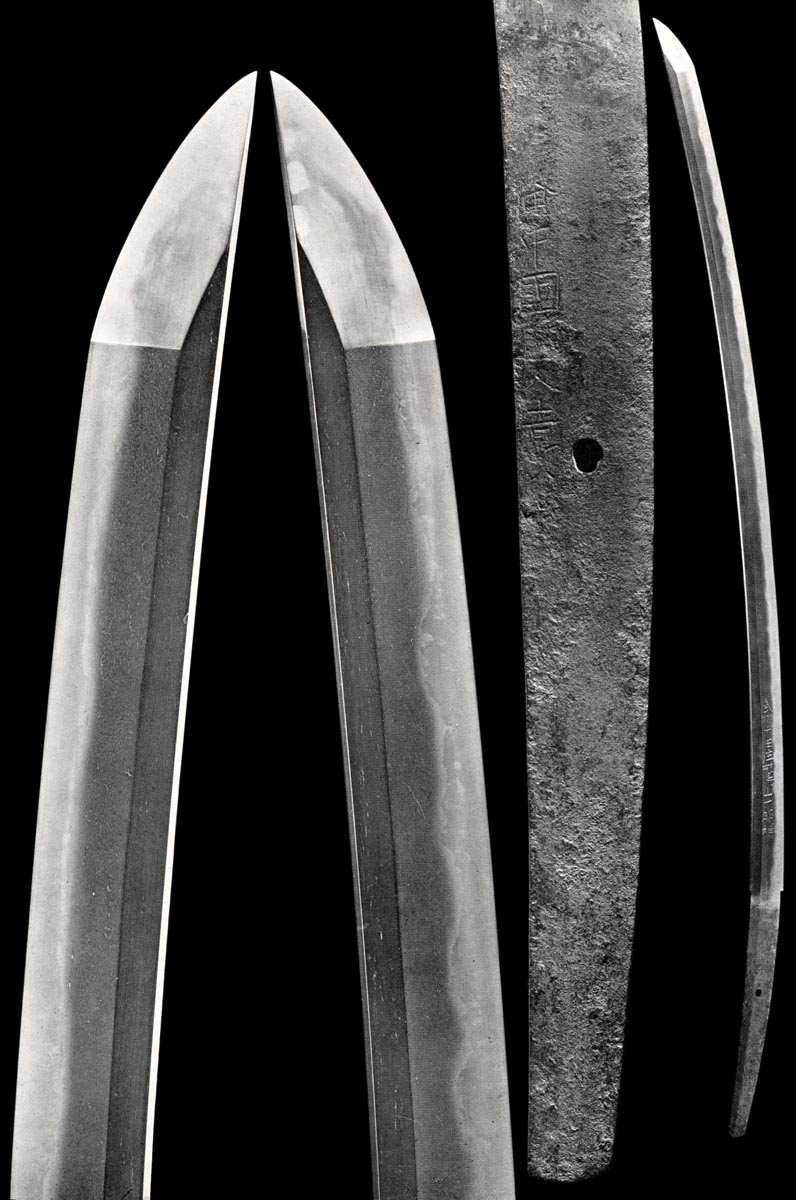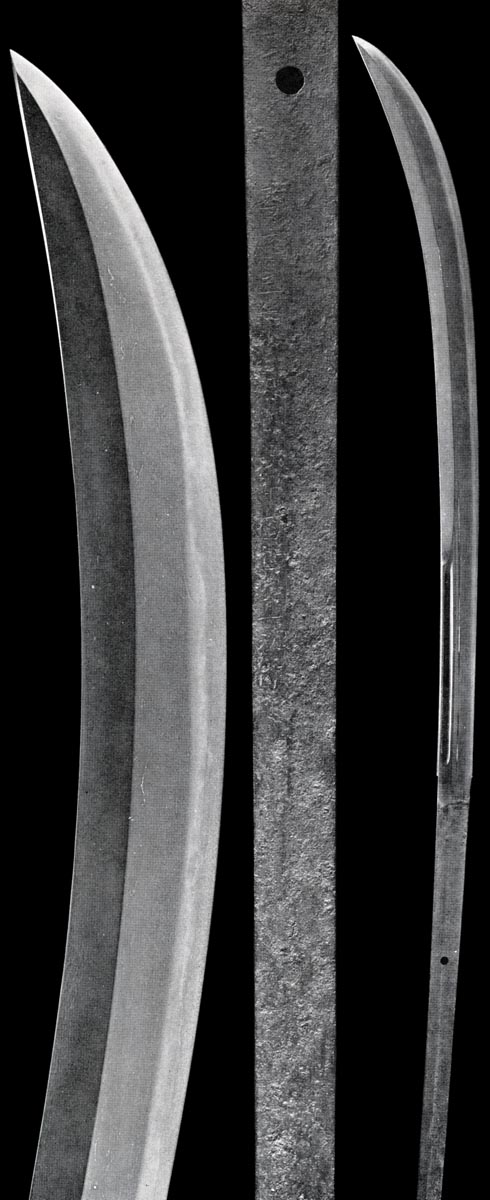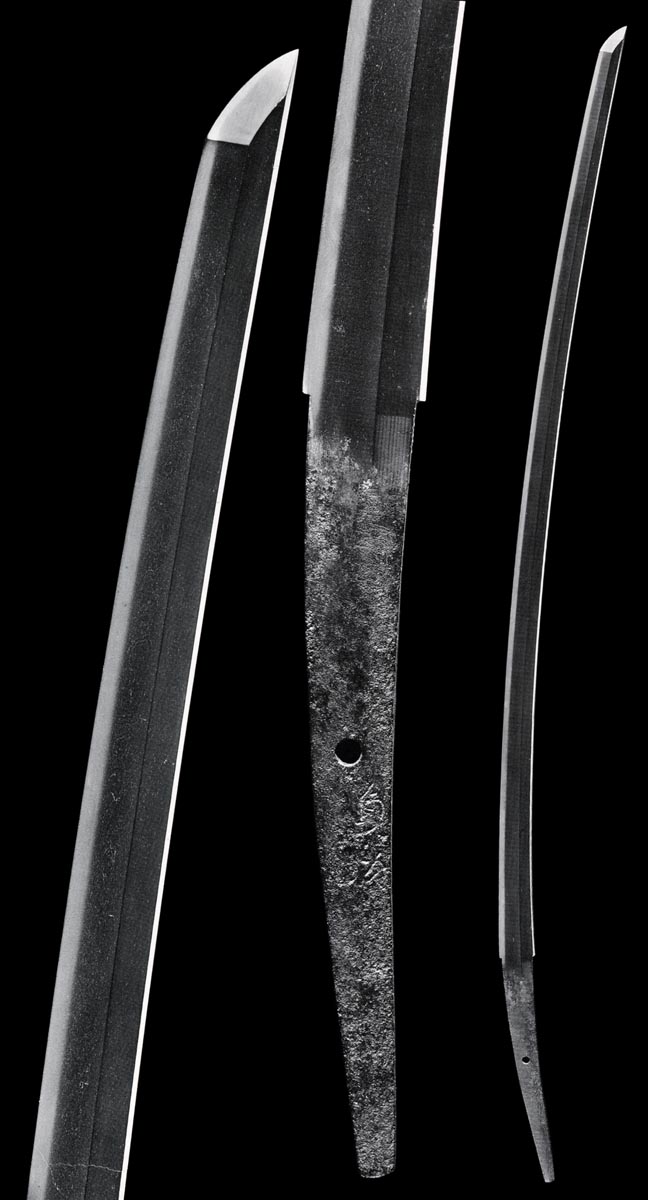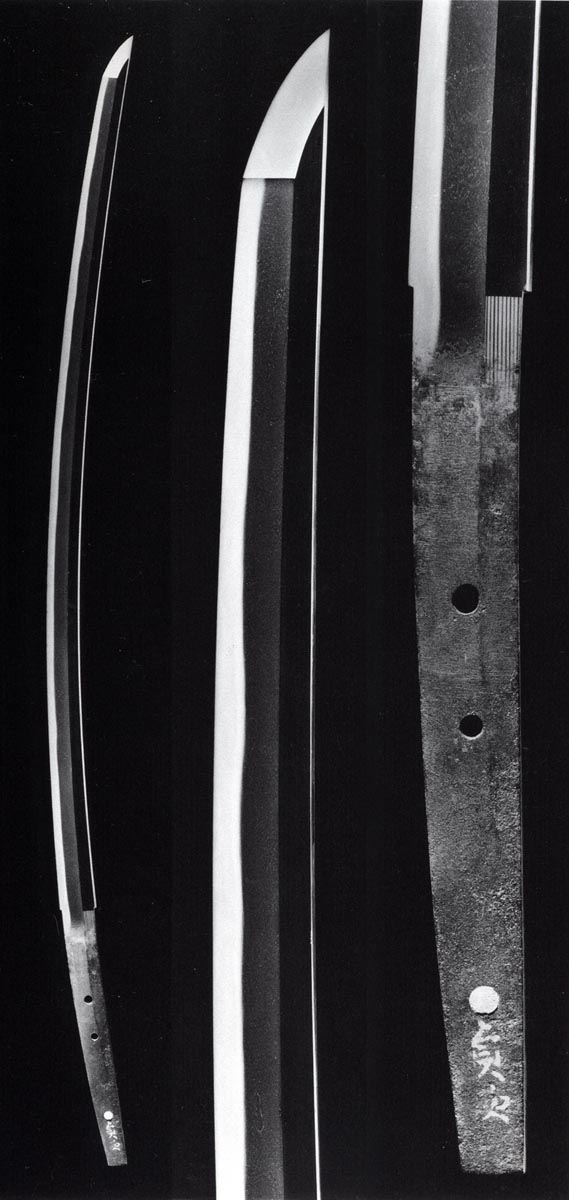| ©
Copyright Robert Cole 2015
- No copying or distributing - The Eight DO SANYODO - The Eight Roads of KOTO |
|
BITCHU CHU-AOE Descendants of the KO-AOE masters and creators of the "AOE Style." AOE is famous for leaning figures in the HAMON and the BITCHU inner-pattern. CHU-AOE school work shows broader and clearer YAKIBA from KO-AOE. Technical: SUGATA - Like early pieces, KOSHIZORI but having KAMAKURA SUGATA of stronger MONOUCHI. SORI appears BIZEN-like. Stout KISSAKI is stronger than BIZEN. NIKU and raised SHINOGI mark the SUGATA distinction - the feeling is strong. HADA - Pronounced and tight KO-MOKUME that appears clear. Less JI-NIE than KO-AOE. "SUMI-HADA" (strings or spots of carbon) is associated. Unique CHIJI-MEN "Bunched-thread" is found. TOBI-like spots of JI-NIE can be "dappled." May show "Threads of a Spider" (white lines). HAMON- The complex YAKIBA of earlier smiths such as TSUGUIYE falls away to wide,clear SUGU with notches. Pattern may be expanded - double or triple CHOJI O-MIDARE TOGARI, however, the famous YAKIBA doubling effect is usually held to the HABUCHI leaving the CHU-AOE mark: broad and clear. SUGU SAKA-MIDARE or SAKA-ASHI is seen. Some SAKA-CHOJI forms may be described as though melted, appearing to puddle and lean together. Tall SAKA TOGARI- CHOJI that appears to topple. SUGUHA may have NEZUMI "Rat's feet," triangle and KAKU-ASHI. KINSUJI against ASHI can appear crevice-like, - making the YAKIBA seem fissured. BITCHU is known for NIOI and KO-NIE of great beauty. BOSHI - MATAGI KOKORO "Forked Tree" -split and swept. Short KAERI. Some TAKIOCHI "Waterfall." NAKAGO - Mostly long and tapering to KURIJIRI. Some long signatures. CHU-AOE Schools: Descendent lines from KO-AOE masters KO-AOE MORITSUGU |__________________ ________________ ____________ __|____________ __|______ __|______ __|_____________ TSUGUIYE School SADATSUGU NOBUTSUGU TAMETSUGU School | TSUGUYOSHI __|____________ __|______________ TAMETSUGU | TSUGUTANE IYETSUGU School YOSHITSUGU School TAMENORI | SANENOBU IYEHISA | IYETSUNA YORITSUGU __|______________ NOBUTSUGU | NAOTSUGU MOROTSUGU TOSHITSUGU School HISATSUGU | KORESHIGE SUKETSUGU __|__________________ SUYETSUGU YOSHITSUGU TOSHICHIRO SHIGETSUGU ______________________ UEMONnoJO MITSUTSUGU CHU-AOE SADATSUGU Line TSUGUNAO ______________________ SUKETSUGU SUYETSUGU CHU-AOE MORITSUGU Line TSUGUZANE MORITSUGU BUN-EI MORITSUGU SADATSUGU CHIKATSUGU EN-KEI MORITSUGU SADATSUGU EN-BUN MORITSUGU SADATSUGU |
_________ MORITSUGU NIN-AN 1166 - KO-AOE ___|_____ SADATSUGU SHO-GEN 1207 - KO-AOE ___|____ IYETSUGU SHO-KYU 1219 - KO-AOE |__________________ __________________ ___|___ ____|____ ____|____ IYEHISA NOBUTSUGU HISATSUGU(1) KO-AN 1278 KEN-CHO 1249 KO-CHO 1261 ____|____ HISATSUGU(2) GEN-TOKU 1329 - CHU-AOE - ____|____ HISATSUGU(3) EN-BUN 1356 IYEHISA KEN-CHO (f: IYETSUGU): KO-MOKUME. KO-CHOJI KO-MIDARE mix. NOBUTSUGU KO-CHO (f: IYETSUGU): KO-ITAME with JI-NIE on CHIJI-MEN "Bunched" HADA. SUMI-HADA. HOSO-SUGU KO-MIDARE HA and SUGUHA with slight NOTARE to KO-CHOJI. ASHI of defined NIOI is well-done and bright. BOSHI: NOTARE - TOGARI-KAERI or KO-MARU. HISATSUGU KO-AN (f: IYETSUGU):SUGUHA with ASHI. HISATSUGU EN-BUN: MOKUME with MASAME. SUGUHA with ASHI. HISATSUGU associated to BUN-PO 1317, GEN-TOKU 1329, EN-BUN 1356 and EI-TOKU 1381. |
|_____________________ ____|___ ____|____ TAMENORI HO-JI 1247 TAMETSUGU(2) KAN-GEN 1243 ____|____ YORITSUGU KO-CHO 1261 ____|____ MOROTSUGU SHO-O 1288 _________ MOROTSUGU EN-BUN 1356 TAMETSUGU(2) KAN-GEN (f: TAMETSUGU 1): Mid-KAMAKURA style TACHI. JI-HADA is marked by CHIKEI.KO-NIE DEKI CHOJI-MIDARE with YO. SUNAGASHI is found. MUNE-YAKI. YORITSUGU KO-CHO (f: TAMENORI): KO-MOKUME with a veil of JI-NIE. HOSO-SUGU KO-MIDARE or shallow NOTARE BA with ASHI. MOROTSUGU SHO-O (f:YORITSUGU): His name given from the long and respected line starting in BUN-JI 1185. SUGU KO-MIDARE. MOROTSUGU EN-BUN: MOKUME. SUGU KO-MIDARE with KO-ASHI and NEZUMI. SAKA CHOJI-MIDARE HA. |
____|_____ TSUGUYOSHI(1) RYAKU-NIN 1238 |____________________________ ____|_____ ____|____ TSUGUYOSHI(2) BUN-EI 1264 TSUGUTANE SHO-O 1288 ____|_____ ____|___ TSUGUYOSHI(3) TOKU-JI 1306 SANENOBU EI-NIN 1293 ____|_____ ____|___ TSUGUYOSHI(4) RYAKU-O 1338 YUKIZANE (MANJUSHO) BUN-PO 1317 TSUGUTANE SHO-O (f: TSUGUIYE): SUMI-HADA. SUGU KO-MIDARE HA. ASHI. TSUGUYOSHI(2) BUN-EI:CHU-AOE. Style of his father. TACHI. ITAME has JI-NIE.This line is known for CHIKEI.KO-NIE SUGU KO-MIDARE BA. MIDARE BOSHI. TSUGUYOSHI(3) TOKU-JI: SAKON SHOGEN. HOSO-SUGUHA. TSUGUYOSHI(4) RYAKU-O:SAKON SHOGEN. His HADA renowned for great beauty. KANJI-like SUMI-HADA KO-ITAME that is evenly veiled in fine JI-NIE. The steel has luminance. NIOI-DEKI SUGUHA where NEZUMI-ASHI calls KO-ASHI from the line. SAKA-CHOJI MIDARE. |
________________________
TOSHITSUGU School Root: Thin YAKIBA. Small patterns with
ASHI
|______________________ ____|____ ____|_____ SUKETSUGU KO-CHO 1261 SHIGETSUGU BUN-EI 1264 ____|____ ____|_____ SUYETSUGU SHO-O 1288 MITSUTSUGU SHO-O 1288 ____|____ SUYETSUGU RYAKU-O 1338 SUKETSUGU KO-CHO (f: TOSHITSUGU): Made somewhat narrow TACHI and KODACHI. CHIJI-MEN no HADA with CHIKEI "coming out." SUGU or CHU-SUGU SAKA KO-CHOJI MIDARE in NIE with ASHI. SUYETSUGU SHO-O (t:SUKETSUGU):KO-ITAME with JI-NIE. CHIJI-MEN HADA. KO-NIE on NIOI-DEKI SUGU CHOJI-MIDARE KO-ASHI. SHIGETSUGU BUN-EI (f: MORITSUGU, grf: TADATSUGU, t: TOSHITSUGU): FUNBARI, KO-KISSAKI TACHI. KOSHIZORI. KO-ITAME with MOKUME having JI-NIE dappled over CHIJI-MEN. SUGUHA of NIE is a KO-MIDARE with ASHI or SUGU CHOJI BA. BOSHI is KO-MARU. Signed TACHI-MEI on the NAKAGO SHINOGI-JI just above the ANA. |
________________ KO-AOE NOBUTSUGU ____|_____ YOSHITSUGU(1) KEN-CHO 1249 |________________________ ____|_____ ___|____ YOSHITSUGU(2) KO-AN 1278 IYETSUNA KO-AN 1278 ____|___ NAOTSUGU(1) SHO-O 1288 |________________________ ____|___ ____|____ NAOTSUGU(2) KEM-MU 1334 KORESHIGE KEM-MU 1334 ____|___ NAOTSUGU(3) O-EI 1394 _____________________ YOSHITSUGU TOSHICHIRO SHO-O 1288 |___________________________________ ________________ ____|_______________ ____|_____ ____|____ YOSHITSUGU UEMONnoJO KA-REKI 1326 CHIKATSUGU MORITSUGU |_______________________ GEN-KO 1331 SHO-KEI 1332 ____|_____ ____|___ _____________ YOSHITSUGU EN-BUN 1356 TSUGUNAO (MARETO) OAN MORITSUGU |______________________ EN-BUN 1356 O-AN 1368 ____|_____ ____|____ _________ YOSHITSUGU EI-WA 1375 SUYETSUGU KAGESHIGE EN-BUN 1356 ____|_____ TEI-JI 1362 ____|____ YOSHITSUGU O-EI 1394 KAGESHIGE O-EI 1394 ____|_____ YOSHITSUGU KA-KICHI 1441 YOSHITSUGU(1) KEN-CHO (f: NOBUTSUGU): Strongly standing MOKUME. SUGU KO-MIDARE. ASHI drops sharply. IYETSUNA KO-AN (f: YOSHITSUGU 1): MOKUME. SUGU KO-MIDARE BA. NAOTSUGU(1) SHO-O (t: YOSHITSUGU): SAEMONnoJO. MOKUME. SUGUHA. NAOTSUGU(2) KEM-MU (f: NAOTSUGU 1): Narrow KO-KISSAKI TACHI with thick KASANE. TANTO are narrow with little or no SORI. KO-MOKUME HADA veiled in JI-NIE. SUMI-HADA. SUGUHA or CHU-SUGU of shallow NOTARE, KO-ASHI and YO. SAKA-ASHI GUNOME-CHOJI MIDARE. KO-NIE in deep NIOI. Long MEI. Tokubetsu Juyo Naotsugu YOSHITSUGU UEMONnoJO KA-REKI (f: TOSHICHIRO): MANJUSHO. UEMONnoJO became SAEMONnoJO. SUE-KAMAKURA style TACHI and narrow MU-SORI TANTO. KO-ITAME of MOKU - pulled and running. JI-NIE veil of dappled, standing UTSURI. SUMI-HADA. NIOI-DEKI SUGUHA with KO-ASHI. SUGU mixed with NOTARE or CHOJI-MIDARE patterns having SAKA-ASHI. Defined NIE and NIOI.MIDARE BOSHI - KO-MARU. Often signed long. YOSHITSUGU EN-BUN: NAMBOKU smith. Wide blade, elongated KISSAKI. SUGUHA of defined NIOI and NEZUMI-ASHI. Patterns of SAKA-CHOJI MIDARE are seen. |
BITCHU CHU-AOE - YOSHITSUGU School
KAGESHIGE EN-BUN: KAGE form: BAN "Evening". AOE. SUGUHA that CHIKATSUGU GEN-KO (f:BIZEN SABEInoJO CHIKATSUGU, t: YOSHITSUGU): From BIZEN to YOSHITSUGU School. Swords in the fashion of earlier styles. KO-MOKUME. GUNOME KO-MIDARE HA. MORITSUGU O-AN: MOKUME. NIOI-DEKI SUGU KO-MIDARE with KO-ASHI and NEZUMI. SAKA CHOJI-MIDARE BA. TSUGUNAO EN-BUN (f: YOSHITSUGU): NAMBOKU. Worked for the South. Made TACHI, NAGAMAKI and long HIRA-TSUKURI O-TANTO. KO-ITAME that is clear. JI-NIE. SUMI-HADA. NIOI-DEKI SUGUHA with SAKA-ASHI is seen, but mainly SAKA-CHOJI MIDARE or shallow NOTARE, SAKA-CHOJI SAKA-ASHI mix in KO-NIE. BOSHI may be TSUKI-AGE "Thrust" TOGARI. Tokubetsu Juyo Tsugunao |
Namboku
Yoshitsugu San-Shaku Tachi - Kokuho Namboku Yoshitsugu Tachi - Kokuho Nagasa: 101.5cm - San-Shaku San-Sun Moto-Haba: 4cm Massive Shrine Gift by Oyama Yoshimasa. Yoshimasa fought for the Southern Cause and died in Seppuku, 1382. Shinogi-Tsukuri, Ihori-Mune with elongated Namboku Kissaki. Blade Inscription in the Ji, both sides. Omote: Bushu Ota Sho Washimiya Daimyojin Ura: Eiwa Ninen (1376) Usuki Jukyu Hi - Yoshimasa Standing Itame Hada has Sumihada. Masame in the Shinogi-Ji. O-Notare of Gunome Choji-Midare Ba in clear Nioi and Mura-Nie. Ashi and Yo. Sunagashi and Kinsuji cut figures where Tobi-Yaki is formed. Midare-Komi Boshi with Tobi-Yaki. Ubu Kurijiri Nakago. Signed in the upper Ji. Bitchu-no-Kuni Junin Yoshitsugu |
Naotsugu
Naginata - Kokuho Naotsugu Naginata - Kokuho Nagasa:59.5cm Moto-Haba: 2.8cm Kanmuri-Otoshi, Mitsu-Mune. Naginata-Hi. Ko-Itame Hada with Ji-Nie and Sumi-Hada. Chu-width Ko-Midare of Saka Ko-Gunome with Saka-Ashi and Sunagashi. Small Tobi-Yaki and Hotsure pull across the Habuchi. Tsuki-age Boshi pulls toward the Saki on either side of the Shinogi. Hachiman Daibosatsu Ryaku-O Gonen x Gatsu Hi Bitschu-no-Kuni Ju Naotsugu Saku |
|
BUNKAZAI TSUGUNAO
 Tokyo National Museum
TSUGUNAO NAGASA: 26.7cm HIRA-TSUKURI, MITSU-MUNE, wide and thin NAMBOKU style TANTO. KO-ITAME HADA has a thin veil of JI-NIE which becomes JIFU. Classic later BITCHU SAKA-CHOJI MIDARE BA. NIOI-FUKASHI forms forms splatter to the side in looping piles. ASHI and YO abound. BOSHI is MIDARE TSUKI-AGE to the point. UBU, one hole, HA-AGARI NAKAGO.OMOTE: BITCHU-no-KUNI JU TSUGUNAO SAKU |
_________ SUKETSUGU EI-NIN 1293 |_______________________ ________________________ ____|____ ____|_____ ___|____ SADATSUGU KEM-MU 1334 TSUGUTSUNE SHO-CHU 1324 SUKETANE ____|____ KEM-MU 1334 SADATSUGU TEI-JI 1362 ____|____ SADATSUGU O-EI 1394 SUKETSUGU EI-NIN: Swords are narrow of KO-ITAME with JI-NIE and SUMI-HADA. SUGUHA of tight NIOI and SAKA KO-ASHI or CHOJI-MIDARE SAKA-ASHI. TSUGUTSUNE SHO-CHU (f:SUKETSUGU):CHU-AOE.Style of his father. SUKETANE KEM-MU (f: SUKETSUGU): MOKUME. SUGUHA. SADATSUGU KEM-MU (f: SUKETSUGU): OSUMI GON-no-SUKE. UEMONTARO. Made wide bodied, CHU-KISSAKI TACHI in TORIIZORI with IHORI-MUNE. 8.5 SUN-style TANTO of normal width having UCHI-ZORI MUNE. SUMI-HADA resides through KO-ITAME of MOKUME with TOBI-like JI-NIE "dappled" on the surface. Highly defined KO-NIE HOSO-SUGU or CHU-SUGUHA where KO-ASHI tends to SAKA. SAKA CHOJI-MIDARE GUNOME-MIDARE with SAKA-ASHI and YO may be found. SADATSUGU TEI-JI: SAIGOTARO. Also, BEInoJO. Spent his later years in INOMATA. Blades are wide and made thin. The YAKIBA can be described as a CHOJI - SAKA-CHOJI mix that becomes particularly expressive and showy. SADATSUGU O-EI (f: TEI-JI SADATSUGU): EMONTARO is thought to have moved to BINGO for the finish of his line. SUGU MIDARE with ASHI. Sadatsugu - Kokuho  Sadatsugu Nagasa: 77.1cm Sori: 2.4cm A possession of the So Family of Tsushima. Shinogi-tsukuri, Ihori-mune Ubu Tachi. Strong Ko-Kissaki. Standing Hada has Sumi-hada. Long, even Hamon of Ko-Choji Midare where Kinsuji charges the mid. Ubu Nakago falls to a small Kurijiri. One Mekugi-ana. Signed next to the Mune. Sadatsugu Chu-Aoe Sadatsugu  Chu-Aoe Sadatsugu Nagasa: 71.2cm Shinogi-tsukuri, Ihori-mune Tachi Sugata with elongated Ko-Kissaki. Itame/Mokume has Sumi-hada and Jifu. Chu-width Ko-Choji Midare Ba. O-Suriage Nakago has three Mekugi-ana, one filled, and gold attribution in the lower. |
|